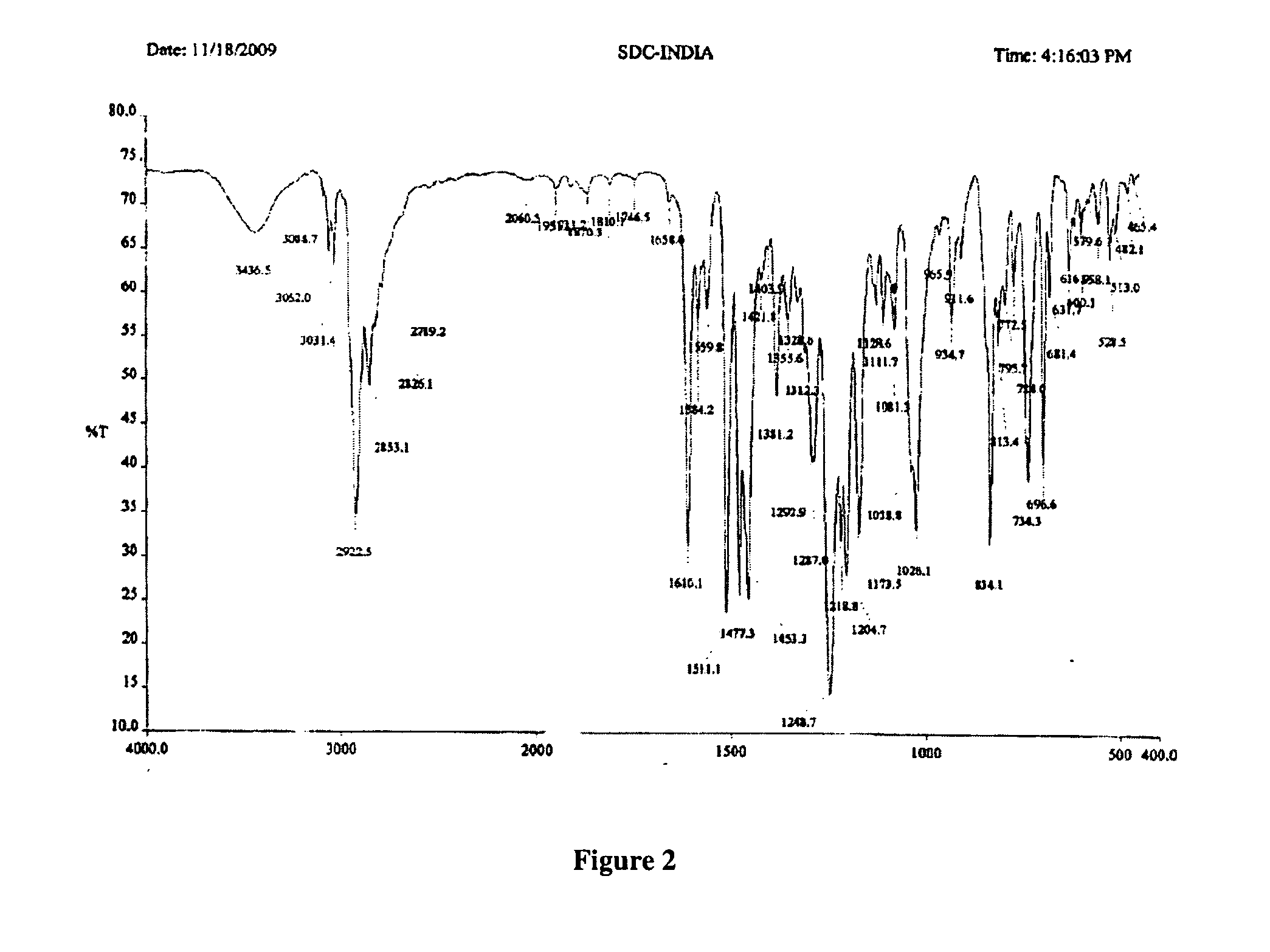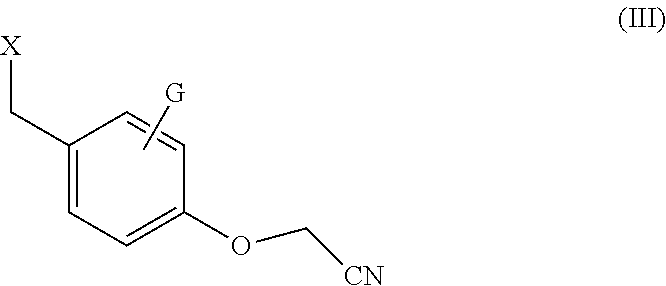Processes for the synthesis of bazedoxifene acetate and intermediates thereof
a technology of bazedoxifene acetate and acetate, which is applied in the field of process for the synthesis of bazedoxifene acetate and intermediates thereof, can solve the problems of incompatibility of functional groups, low yield of desired products, and potential operational problems of the reduction of ester functionality with lithium aluminium hydride, and achieves low cost and high purity.
- Summary
- Abstract
- Description
- Claims
- Application Information
AI Technical Summary
Benefits of technology
Problems solved by technology
Method used
Image
Examples
example 1
Synthesis of (4-Hydroxymethyl phenoxy)acetonitrile (Formula II)
[0069]4-Hydroxy benzyl alcohol (100 g, 0.8 mole) was dissolved in acetone (800 ml). Solid potassium carbonate (390 g, 2.8 mole) was added and stirred (15 min). Chloroacetonitrile (73 g, 0.9 moles) was added to the slurry and refluxed at 55-56° C. for 7 h (TLC, 10% MeOH in CHCl3 absence of starting material). The slurry was filtered and filtrate concentrated to get off white solid. It was suspended in toluene (600 ml) and stirred for 1 hour. Product was then filtered and washed with toluene and dried in vacuum. wt.—118 g ; Yield: 90%.
[0070]HPLC Purity: 97.1%
[0071]1H NMR (CDCl3) δ 1.64 (bs, 1H), 4.63 (s, 2H), 4.77 (s, 2H), 6.99 (d, 2H, J=8 Hz), 7.34 (d, 2H, J=12 Hz) (ESI) 162(M−1)+.
example 2
Synthesis of (4-chloromethyl phenoxy)acetonitrile (Formula III)
[0072](4-Hydroxymethyl phenoxy)acetonitrile (Formula II) (75 g, 0.46 mole) of Example 1 was suspended in toluene (500 ml) and DMF (3.75 g). Thionyl chloride (66 ml, 0.55 moles) in toluene (150 ml) was added slowly and stirred at 0-5° C. for 2-3 h (TLC-60% EtOAc: 40% hexane-absence of starting material). Reaction was quenched with water (500 ml), layers separated and toluene layer washed with saturated sodium bicarbonate (2×200 ml) and 200 ml of distilled water. Toluene was concentrated to obtain a white solid which was suspended in n-heptane (375 ml), stirred for 30 minutes and filtered , dried in vacuum to get (4-chloromethyl phenoxy)acetonitrile (Formula III) (70 g; Yield: 84%)
[0073]HPLC Purity: 95.5%
[0074]1H NMR (CDCl3) δ 4.57 (s, 2H), 4.77 (s, 2H), 6.98 (d, 2H, J=8 Hz), 7.37 (d, 2H, J=12 Hz).
[0075]MS (ESI) 146.1 (M−35.5)+.
example 3
Synthesis of {4-[5-Benzyloxy-2-(4-benzyloxy-phenyl)-3-methyl indol-1-ylmethyl]-phenoxy}-acetonitrile (Formula V)
[0076]2-substituted indole derivative (Formula IV) (80 g g, 0.19 mole) was dissolved in N,N-dimethyl formamide (DMF) (400 ml), cooled to 10-15° C. Sodamide (22.4 g, 0.57 moles) was added and stirred for 15 min. (4-chloromethyl phenoxy)acetonitrile (Formula III) of example 2 (44 g, 0.24 mole) in DMF (160 ml) was added drop wise completion, and stirred for 2-3 h at 10-15° C. (TLC, 30% EtOAc-hexane-absence of starting material). After reaction was quenched with ice-cold water (1400 ml), extracted with toluene (800 ml) and aqueous layer extracted with toluene (200 ml). Combined toluene layers were washed with saturated brine solution (2×150 ml) and Toluene was recovered under vacuum to get an off-white material. It was suspended in 800 ml Methanol and stirred for 1 hour at room temperature and filtered, washed with methanol 100 ml×2 and dried under vacuum to get an off white i...
PUM
| Property | Measurement | Unit |
|---|---|---|
| pH | aaaaa | aaaaa |
| acid | aaaaa | aaaaa |
| purity | aaaaa | aaaaa |
Abstract
Description
Claims
Application Information
 Login to View More
Login to View More - R&D
- Intellectual Property
- Life Sciences
- Materials
- Tech Scout
- Unparalleled Data Quality
- Higher Quality Content
- 60% Fewer Hallucinations
Browse by: Latest US Patents, China's latest patents, Technical Efficacy Thesaurus, Application Domain, Technology Topic, Popular Technical Reports.
© 2025 PatSnap. All rights reserved.Legal|Privacy policy|Modern Slavery Act Transparency Statement|Sitemap|About US| Contact US: help@patsnap.com



